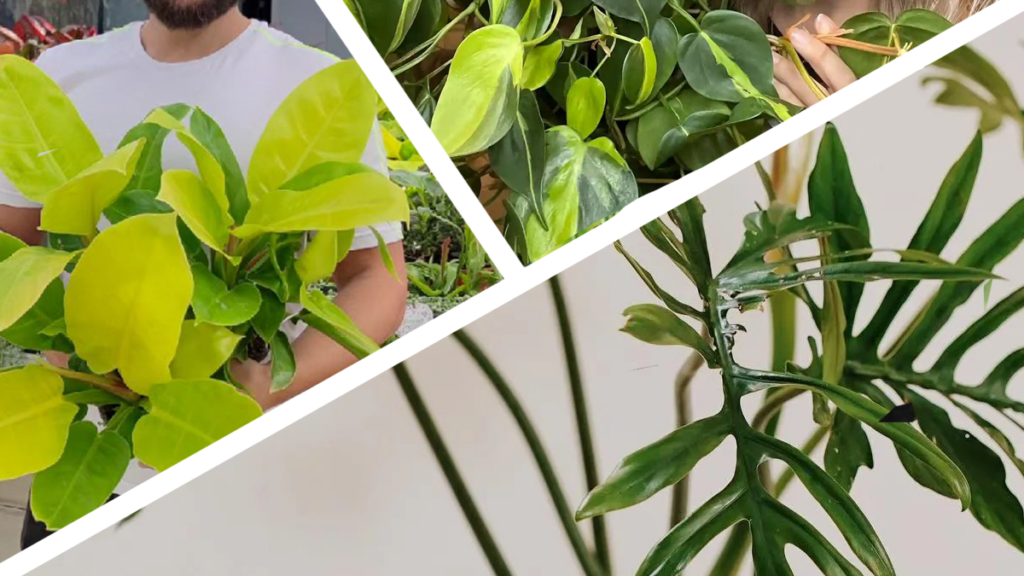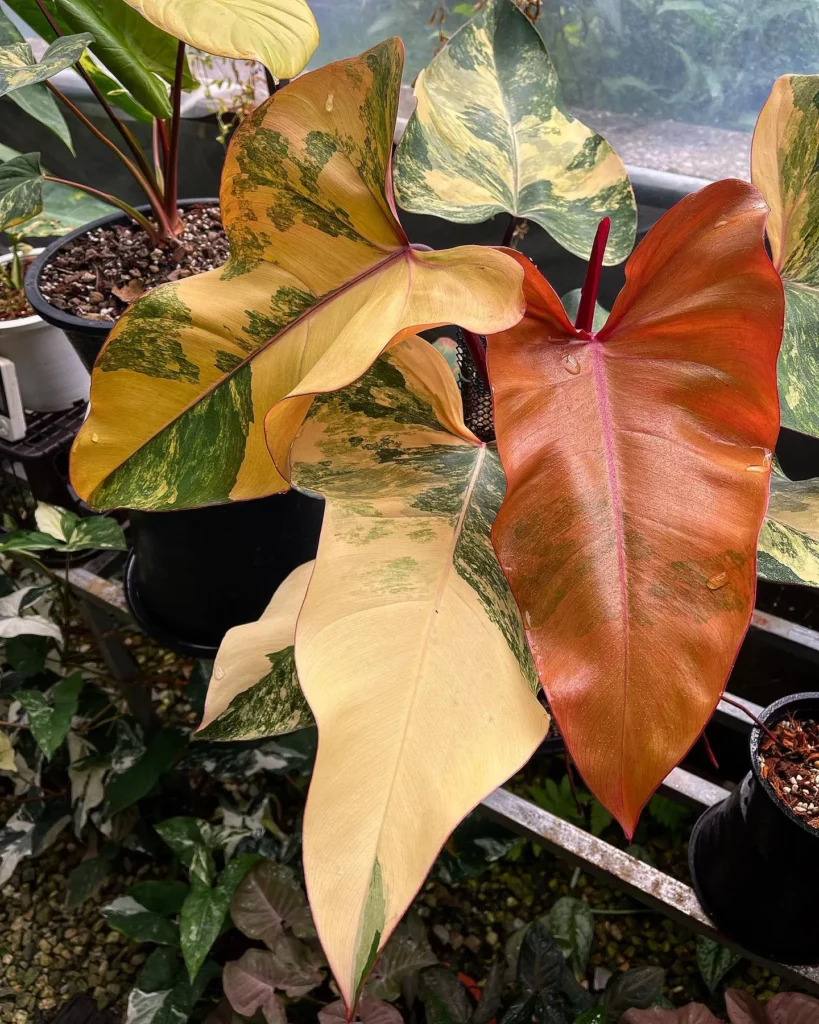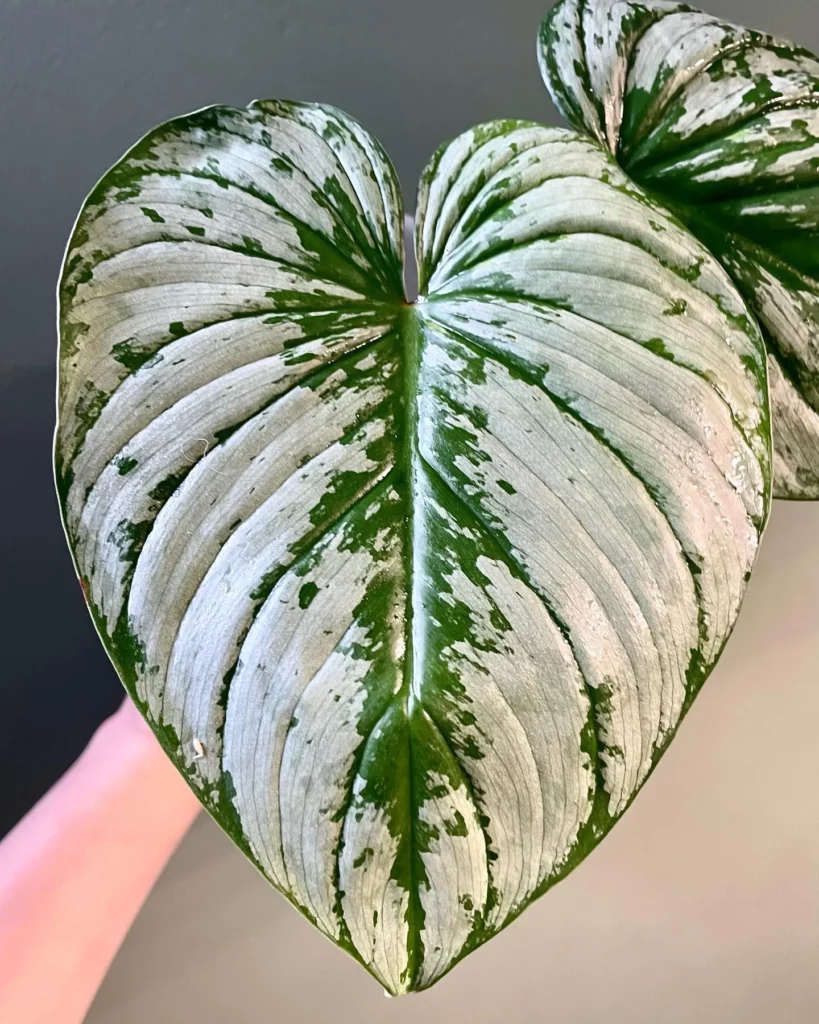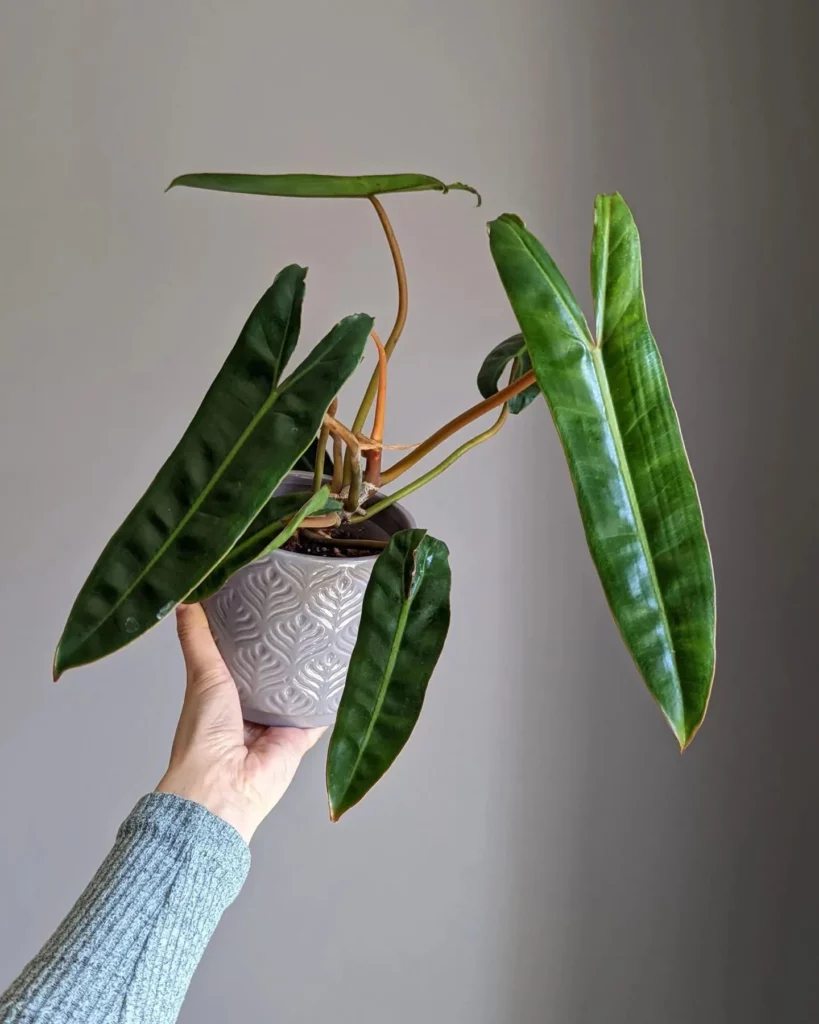Welcome to my comprehensive care guide for the unique Silver Sword Philodendron Hastatum, also known as Philodendron silver sword. This stunning vining plant with silver-toned lance-like leaves is sure to add a touch of sophistication to any space. Whether you’re a beginner or an experienced plant parent, this care guide will provide all the necessary information to keep your Silver Sword Philodendron thriving and looking its best.
Key Takeaways:
- Learn how to care for the Silver Sword Philodendron Hastatum, a stunning vining plant with silver-toned leaves.
- Get tips on potting, repotting, and propagating the Silver Sword Philodendron to ensure healthy growth.
- Understand the safety considerations of having the Silver Sword Philodendron around pets and children.
Overview of the Silver Sword Philodendron



The Silver Sword Philodendron, also known as Philodendron Hastatum, is a stunning vining plant with lance-like leaves that have an attractive bluish-silver hue. This unique variety starts as a terrestrial plant and eventually transforms into an aerial plant as it matures. The leaves elongate and take on more arrow-shaped forms, creating a visually striking foliage. With the right conditions, this Philodendron can reach a height of 1m, making it an impressive addition to any indoor space.
Growth Cycle and Foliage
The Silver Sword Philodendron goes through a fascinating growth cycle. It begins as a ground-dwelling plant, producing foliage that is compact and close to the soil. As it grows, the plant starts to climb and transition into an aerial form, developing elongated leaves with a distinct silver-toned appearance. The lance-like leaves of the Silver Sword Philodendron are a key feature, adding elegance and sophistication to its overall aesthetic.
Versatility and Adaptability
The Silver Sword Philodendron is a versatile plant that can thrive in various settings. Whether you choose to grow it in a hanging basket, allow it to trail along a trellis, or let it climb a moss pole, this vining plant adapts well to different conditions. Its ability to tolerate a range of light intensities, from low to bright indirect sunlight, makes it suitable for various indoor environments. Additionally, its unique growth pattern and attractive foliage make it a popular choice among plant enthusiasts and collectors.
Benefits of the Silver Sword Philodendron
- Eye-catching foliage with silver-toned lance-like leaves
- Ability to adapt to different lighting conditions
- Low-maintenance plant that adds elegance to any space
- Can be grown as a climbing or trailing plant
- Enhances indoor air quality by filtering toxins
Silver Sword Philodendron Care



Taking care of the Silver Sword Philodendron, also known as Philodendron Hastatum, is relatively easy. As a member of the Araceae family, it shares similar care requirements with other Philodendrons. Here are some essential care tips to keep your Silver Sword Philodendron thriving:
1. Provide Bright Indirect Sunlight
The Silver Sword Philodendron thrives in bright indirect sunlight. Place it near a window where it can receive filtered light throughout the day. Avoid exposing it to direct sunlight for extended periods as it can scorch the leaves and cause damage.
2. Use Well-Drained Soil
Ensure your Silver Sword Philodendron is planted in well-drained soil. A mixture of coco coir, perlite, and organic matter such as earthworm castings works well. This type of soil combination allows excess water to drain away, preventing root rot.
3. Maintain Moderate to High Humidity
The Silver Sword Philodendron enjoys moderate to high humidity levels. If your home has lower humidity, you can increase it by misting the plant, using a pebble tray, or placing it in a bathroom. This will help create an environment similar to its natural habitat in tropical rainforests.
4. Water Regularly, but Avoid Overwatering
Water your Silver Sword Philodendron regularly to keep the soil moist. However, be careful not to overwater, as this can lead to root rot. Allow the top inch of soil to dry out before watering again. Adjust your watering frequency based on the temperature and humidity levels of your environment.
Silver Sword Philodendron Light Requirements: Thriving in Bright Indirect Sunlight


The Silver Sword Philodendron, also known as Philodendron Hastatum, is a stunning plant that requires specific light conditions to thrive. While it can tolerate a wide range of light levels, it thrives best in bright indirect sunlight. Placing the plant near a window with indirect sun streaming in will result in vibrant foliage and vigorous growth. However, it is essential to avoid prolonged exposure to direct sunlight, as it can scorch the leaves and cause permanent damage.
Inadequate lighting can result in leggy stems, indicating that the plant is not receiving enough light. If you notice this, consider moving the Silver Sword Philodendron to a brighter location to ensure its optimal growth and development.
Factors to Consider for Ideal Light Conditions:
- Placement: Choose a spot near a window with bright, indirect sunlight.
- Avoid direct sunlight: Prolonged exposure to direct sunlight can cause leaf burn and damage.
- Monitor light levels: Regularly assess the lighting conditions to ensure they are suitable for the Silver Sword Philodendron’s needs.
Silver Sword Philodendron Watering: Keeping Your Moisture-Loving Plant Thriving
Proper watering is essential for the health and vitality of your Silver Sword Philodendron. As a moisture-loving plant, it requires consistent and careful watering to thrive. Here are some key guidelines to follow when watering your Silver Sword Philodendron:
- Check the soil moisture: Before watering, always check the moisture level of the soil. Insert your finger about an inch deep into the soil; if it feels dry, it’s time to water. If it still feels moist, wait a few more days before watering again.
- Watering frequency: The frequency of watering will depend on various factors such as climate, humidity, and pot size. As a general rule, water your Silver Sword Philodendron thoroughly when the top inch of soil feels dry. Avoid overwatering, as this can lead to root rot and other problems.
- Watering technique: When watering, pour water slowly and evenly onto the soil until it starts to drain from the bottom of the pot. This ensures that the entire root system gets adequately hydrated.
- Well-drained soil: It’s crucial to use a well-draining soil mix for your Silver Sword Philodendron. This allows excess water to flow out of the pot, preventing waterlogged soil that can suffocate the roots.
Other Considerations for Watering:
Humidity: The Silver Sword Philodendron thrives in high humidity levels, so it’s beneficial to increase humidity around the plant. You can achieve this by misting the leaves with water, placing the plant on a pebble tray filled with water, or using a humidifier in the room.
Seasonal variations: Adjust your watering routine based on the season. During the warmer months, the plant may require more frequent watering due to increased evaporation, while in winter, you may need to reduce watering frequency as the plant enters a dormant phase.
Monitoring your plant: Keep a close eye on your Silver Sword Philodendron and observe how it responds to watering. Yellowing leaves or wilting can be signs of overwatering, while dry, brown tips may indicate underwatering. Adjust your watering schedule accordingly to ensure optimal health.
Humidity and Temperature for the Silver Sword Philodendron
The Silver Sword Philodendron, native to tropical rainforests, thrives in high humidity environments. In order to create the ideal conditions for this plant, aim for a humidity level of approximately 75%. If your home has lower humidity, there are several ways to increase it. You can mist the plant regularly, use a pebble tray filled with water, cluster your Philodendrons together, or even place the plant in a bathroom where humidity tends to be higher.
When it comes to temperature, the Silver Sword Philodendron prefers average room temperatures between 15-27°C (59-80°F). It is important to avoid exposing the plant to extreme temperatures, as it can negatively impact its growth and overall health. Keep in mind that this variety is sensitive to cold drafts, so make sure to protect it from chilly air currents.
Creating a Humid Environment
- Mist the plant daily or use a humidifier to increase humidity levels.
- Place a tray filled with water and pebbles near the plant to create a humid microclimate.
- Cluster your Philodendrons together to increase humidity around the plants.
- If possible, place the Silver Sword Philodendron in a naturally humid area of your home, such as a bathroom.
Temperature Considerations
- Maintain average room temperatures between 15-27°C (59-80°F) for optimal growth.
- Avoid exposing the plant to extreme temperatures, especially cold drafts.
- Protect the Silver Sword Philodendron from sudden temperature fluctuations.
Silver Sword Philodendron Soil and Fertilizing Guide
Creating the right soil environment for your Silver Sword Philodendron is crucial for its overall health and growth. This stunning vining plant thrives in loose, well-draining soil that is rich in organic matter. A combination of coco coir, perlite, and organic matter such as earthworm castings provides the perfect soil mix. The coco coir and perlite enhance drainage, preventing waterlogged soil and root rot, while the organic matter provides essential nutrients.
To ensure your Silver Sword Philodendron receives the necessary nutrients, it’s important to fertilize it regularly. A balanced liquid fertilizer diluted to half-strength should be applied monthly during the spring and summer months. This will provide the plant with the right amount of nutrients for vigorous growth. Avoid over-fertilizing, as it can lead to salt buildup in the soil, causing damage to the roots.
Soil Tips:
- Use a well-draining soil mix with coco coir, perlite, and organic matter.
- Avoid waterlogged soil by ensuring proper drainage.
- Earthworm castings can be a great source of organic matter for the soil.
Fertilizing Tips:
- Apply a balanced liquid fertilizer diluted to half-strength monthly during the spring and summer.
- Avoid over-fertilizing to prevent salt buildup in the soil.
- Consider using organic fertilizers for a more natural approach.
Potting and Repotting the Silver Sword Philodendron
Proper potting and repotting are essential for the health and growth of your Silver Sword Philodendron. Here are some guidelines to follow:
Pot Selection
- Choose pots with good drainage to prevent waterlogging and rot.
- Hanging baskets can enhance the aesthetic appeal of this vining plant, allowing it to trail gracefully.
- Ensure the pot is the right size for your plant, with a little extra room for growth.
Well-Draining Soil
The Silver Sword Philodendron thrives in well-draining soil that is rich in organic matter. Here’s a simple soil mix recipe:
- Mix equal parts coco coir and perlite for optimal drainage.
- Add some organic matter, such as earthworm castings, to provide nutrients.
- This loose soil mix allows the roots to breathe and prevents waterlogging.
Repotting
Repot your Silver Sword Philodendron when you notice the roots coming out of the pot or when it becomes root-bound. Spring and summer are the ideal times for repotting, as the plant is in its active growth phase. Follow these steps:
- Gently remove the plant from its current pot, taking care not to damage the roots.
- Place a layer of fresh soil mix in the new pot.
- Position the plant in the center and fill the remaining space with soil, gently firming it around the roots.
- Water the newly repotted plant thoroughly to settle the soil, and then resume your regular care routine.
Propagation of the Silver Sword Philodendron
If you’re looking to expand your collection of Silver Sword Philodendrons, propagation is a great way to do it. With stem cuttings, you can create new plants and fill your space with these stunning beauties. Here’s how to propagate the Silver Sword Philodendron:
- Select a healthy base plant with strong stems and vibrant foliage.
- Cut a stem just below a node using clean, sharp pruning shears.
- Remove any lower leaves from the cutting to ensure that no leaves will be submerged in water or soil.
- Place the cutting in a glass of water or directly in a pot with a well-draining soil mix.
- Keep the cutting in a warm, bright location with indirect sunlight.
- Change the water every few days to prevent bacterial growth or root rot.
- Within a few weeks, roots will develop, and the cutting can be transplanted into a pot or garden plot.
Common Pests and Diseases of the Silver Sword Philodendron
When caring for your Silver Sword Philodendron, it’s important to be aware of common pests and diseases that can affect this stunning plant. By keeping an eye out for signs of infestation or illness, you can take proactive measures to protect and maintain the health of your Philodendron.
Pests:
- Spider mites: These tiny pests can cause webbing and discoloration on the leaves. Regularly inspect the undersides of the leaves for signs of mites and treat them with a neem oil solution.
- Scale bugs: These insects appear as small bumps on the leaves and stems. Remove them manually or apply horticultural oil to suffocate and eliminate them.
- Mealybugs: Mealybugs are cottony pests that can cluster on the foliage. Use a cotton swab dipped in rubbing alcohol to remove them, or apply insecticidal soap.
- Thrips: Thrips are tiny flying insects that can cause silver scars on the leaves. Use sticky traps or insecticidal soap to control their population.
Diseases:
- Bacterial leaf spot: This disease appears as small, brown or rust-colored spots on the leaves. Remove affected leaves and maintain good airflow to prevent its spread. Avoid overhead watering.
- Fungal diseases: Silver Sword Philodendrons can be susceptible to fungal infections such as leaf blight. Ensure proper watering practices and avoid excessive moisture on the leaves.
Toxicity and Safety Considerations of the Silver Sword Philodendron
When it comes to the Silver Sword Philodendron, it’s important to be aware of its potential toxicity to both pets and humans. While this plant may be a stunning addition to your space, it can cause gastrointestinal discomfort if ingested. Therefore, it’s crucial to keep it out of reach of curious pets and children.
If you suspect that someone, including a pet, has ingested any part of the Silver Sword Philodendron, it’s advisable to seek medical assistance immediately. While this plant may not be deadly, it’s always better to err on the side of caution. Prompt consultation with a medical professional or veterinarian can ensure the best course of action.
As a responsible plant owner, it’s crucial to educate yourself and take necessary precautions to keep both your loved ones and your plants safe. By practicing proper placement and handling, you can continue to enjoy the beauty of the Silver Sword Philodendron without compromising anyone’s well-being.
FAQ
Is the Silver Sword Philodendron the same as Philodendron Hastatum?
Yes, the Silver Sword Philodendron is also known as Philodendron Hastatum. They refer to the same plant.
What is the ideal light condition for the Silver Sword Philodendron?
The Silver Sword Philodendron thrives best in bright indirect sunlight. Avoid prolonged exposure to direct sunlight, as it can damage the foliage.
How often should I water my Silver Sword Philodendron?
Water the plant regularly to keep the soil moist, but avoid overwatering to prevent root rot. Water when the top inch of soil feels dry.
How can I increase the humidity for my Silver Sword Philodendron?
You can increase humidity by misting the plant, using a pebble tray, clustering Philodendrons together, or placing the plant in a bathroom.
What type of soil should I use for the Silver Sword Philodendron?
The Silver Sword Philodendron thrives in loose, well-draining soil rich in organic matter. A mixture of coco coir, perlite, and organic matter is ideal.
When should I repot my Silver Sword Philodendron?
Repot the plant when the roots start coming out of the pot or when it outgrows its current container. Repotting is typically done in spring and summer.
How can I propagate the Silver Sword Philodendron?
The Silver Sword Philodendron can be easily propagated through stem cuttings. Place the cutting in water or directly in a well-draining soil mix.
What are the common pests and diseases of the Silver Sword Philodendron?
Common pests include spider mites, scale bugs, mealybugs, and thrips. The plant can also be affected by bacterial leaf spot diseases and fungal diseases.
Is the Silver Sword Philodendron toxic?
Yes, the Silver Sword Philodendron is considered toxic to pets and humans if ingested. Keep the plant out of reach and handle with caution.




